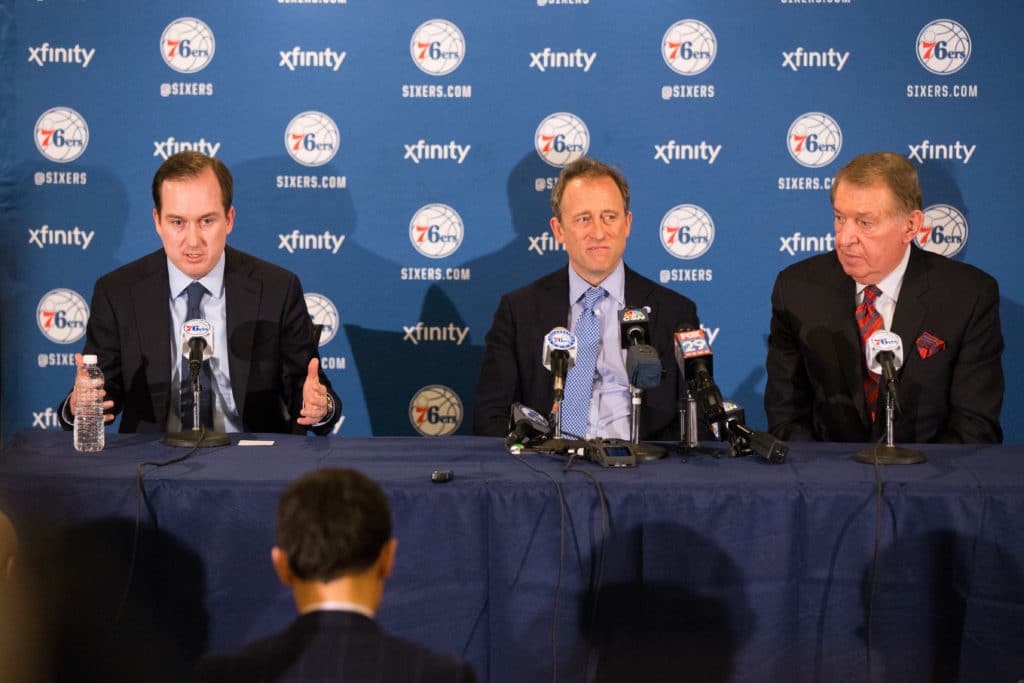Ad Disclosure
To Appreciate Sam Hinkie’s Philadelphia Tenure, We Need to Look at the Decade Preceding His Arrival

94 WIP is in the middle of a specially branded five-day stretch dubbed “Once and For All Week,” in which hosts are taking the hottest debates in Philadelphia sports history and settling them… once and for all. They talked about Donovan McNabb on Monday, the 2008 Phillies on Tuesday, and today they’re asking if Sam Hinkie was good at his job.
That presented us with dueling columns on the WIP website from father/son duo Spike and Howard Eskin, and of course Spike is correct on the Hinkie topic.
Hinkie had one job, that was to put the Philadelphia 76ers in the best possible position to win a championship. It would have been impossible to take larger steps than what Hinkie did in his less than three years as lead decision maker for the team.
To accomplish this one job, he had one very simple plan: take as many chances as he could to get superstar players in the draft, and use as much of the rest of the roster as he could to find and develop players that flew a little further under the radar.
…
Through a series of intelligent trades, draft picks and signings, he took a team whose cupboard was basically bare and stuck in the hamster wheel of mediocrity, and transformed it into a collection of young players, future draft picks, and cap space that has rarely been duplicated.
The portion in bold is what’s most important.
Hinkie’s tenure in Philadelphia, to me, is defined more from a macro perspective while the individual moves should be parsed separately.
One only has to look at what the Sixers were from 2003 to 2013 to justify the installation and execution of the Process. In that span of ten seasons, the team won 333 games, lost 389 games, and won a grand total of one playoff series, defeating the Derrick Rose-less Chicago Bulls in round one after the lockout-shortened season. Prior to that asterisk-riddled campaign, Sixer fans watched eight-straight seasons in which the team went 0-4 in playoff series.
That’s the definition of mediocrity, treading water as a seven seed and bowing out to the Pistons and Magic in April. This team had some decent pieces in Jrue Holiday and Thad Young, but it was a squad with a relatively low ceiling that generated little excitement in its home market.
In comes Sam Hinkie to blow it up and execute a direly-needed rebuild, which helped push the franchise into relevance.
Yes, the losing was painful, but after 10 years of utterly average basketball, a forward-thinking portion of Sixers fans understood that the team was taking three steps backward in order to take four steps forward. Even with the Hinkie resignation and Colangelo disaster, this team mustered consecutive 50-win seasons and went to seven games with the eventual NBA champion Toronto Raptors.
All of the other micro-level Hinkie stuff can be debated ad nauseam. You can talk his draft history and his introverted nature and his ridiculous resignation letter. He did not have a great relationship with agents and he certainly did not execute a flawless and clean rebuild. To me, the biggest negative from his tenure is that the divisive nature of the process has resulted in a residual and intense divide in fan opinion, which is split down generational lines. A lot of older Philly sports fans, like Howard, believe that the process can only be justified with a championship, right now. Younger fans don’t think this way, yet the result is an immense amount of pressure placed on the shoulders of Ben Simmons, Joel Embiid, and Brett Brown, who are tasked with matching an incredibly high level of expectation. This is not the same for small market teams rebuilding traditionally through the draft, who did not implement a controversial rebuild to get from point A to point B.
But Hinkie’s tenure should be judged primarily on the macro-level application of a badly-needed restart, and the bottom line is that the post-Hinkie Sixers were in a better position to compete and win than at any time during the ten years prior to his arrival.
Kevin has been writing about Philadelphia sports since 2009. He spent seven years in the CBS 3 sports department and started with the Union during the team's 2010 inaugural season. He went to the academic powerhouses of Boyertown High School and West Virginia University. email - k.kinkead@sportradar.com